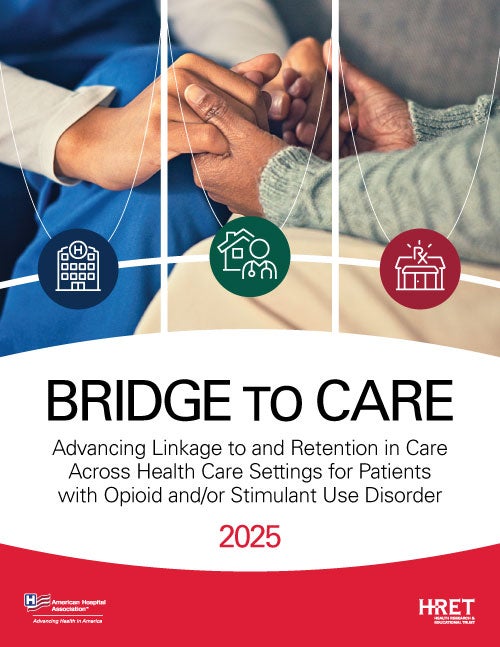For patients living with Opioid Use Disorder and/or Stimulant Use Disorder, transitions between inpatient, primary care and pharmacy settings are pivotal moments that can impact which direction their recovery journey takes. Ensuring that patients are on a healing path is critical, considering the size and scope of the overdose crisis in the United States.
In fall 2024, the Centers for Disease Control and Prevention (CDC) awarded the American Hospital Association’s (AHA’s) Health Research & Educational Trust (HRET) a grant to pursue the following goals:
- Develop three evidence-based and evidence-informed toolkits that detail leading practices for linkage to and retention in OUD and StUD care for inpatient, primary care and pharmacy settings.
- Partner with hospital and health system implementers to incorporate the toolkit strategies into their practice and clinical workflow.
- Track the uptake and use of the toolkits in each clinical setting to refine and improve recommendations based on the implementers’ on-the-ground experiences.
- Finalize the toolkits based on feedback from implementers and subject matter experts.
To address the above objectives, AHA/HRET partnered with clinician teams spanning inpatient, primary care and pharmacy settings from three hospital and health system implementers — Oregon Health and Science University Health Care (OHSU), Trinity Health of New England (THONE) and University of Kentucky (UK HealthCare).
Together, the teams developed the content of this toolkit, using best practices identified through a literature review and the evidence-informed practices being used within their organizations. Across work with health system implementers and in the literature, three focus areas consistently emerged as essential to improving linkage to and retention in care: expanding access to care, fostering strong leadership commitment and ensuring continuous education and communication among care teams.
This toolkit offers leading practices as a framework for action across inpatient, primary care and pharmacy settings, with toolkits provided for each setting. AHA/HRET has identified both challenges and opportunities and detailed them in alignment with the three focus areas for improving linkage to and retention in care. Note that due to the interconnected nature of OUD and StUD care, information about both conditions will often look similar across settings throughout the report.
Development of this resource toolkit was supported by contract number PHIC 24-00-80, funded by the U.S. Centers for Disease Control and Prevention (CDC). The contents do not necessarily represent the official views of CDC or the Department of Health and Human Services, and should not be considered an endorsement by the Federal Government.
The findings and conclusions in this report are those of the authors and do not necessarily represent the views of the Centers for Disease Control and Prevention (CDC).
Mention of trade names, commercial products, or organizations does not imply endorsement by the CDC or U.S. Government.

Chapter 1:
The Role of Inpatient Care
Inpatient clinical teams can support patients with OUD and/or StUD in connecting to care as they transition into or from the inpatient setting to other settings — even in the absence of an addiction consult service. This chapter of the toolkit provides ideas to address common challenges in accessing and offering OUD and StUD services in inpatient care settings and maintaining linkage and retention in care upon discharge.

Chapter 2:
The Role of Primary Care
Primary care teams play a crucial role in ensuring patients with OUD and/or StUD are linked and retained through the health care system smoothly and continue to receive needed care. This chapter highlights challenges in providing OUD and StUD treatment in primary care and the roles that primary care teams can play in gaining organizational commitment for resources that support linkage and retention in care and strategies for educating key stakeholders on this work.

Chapter 3:
The Role of Pharmacy
Pharmacists play a vital role in providing medication, clinical counseling and supportive care services to patients with OUD and/or StUD across the continuum of care, with medication forming the foundation of effective treatment for OUD. This chapter of the toolkit highlights some of the challenges pharmacists can face in helping patients access medications and explores potential ideas for addressing these challenges, the roles that pharmacy teams can play in gaining leadership buy-in and commitment and strategies for educating key stakeholders to improve care transitions.
Supplemental Information

Case Examples
Learn about the interventions tested and implemented by OHSU, UK HealthCare and THONE to improve linkage and retention for patients with OUD and/or StUD.

Suggestions for Future Work
Explore ideas for researchers, for hospitals and health systems and for hospital and health care associations to support linkage and retention efforts.

Supporting Research
View a comprehensive literature review prepared by AHA/HRET highlighting peer-reviewed research that informed the content of the toolkit.



